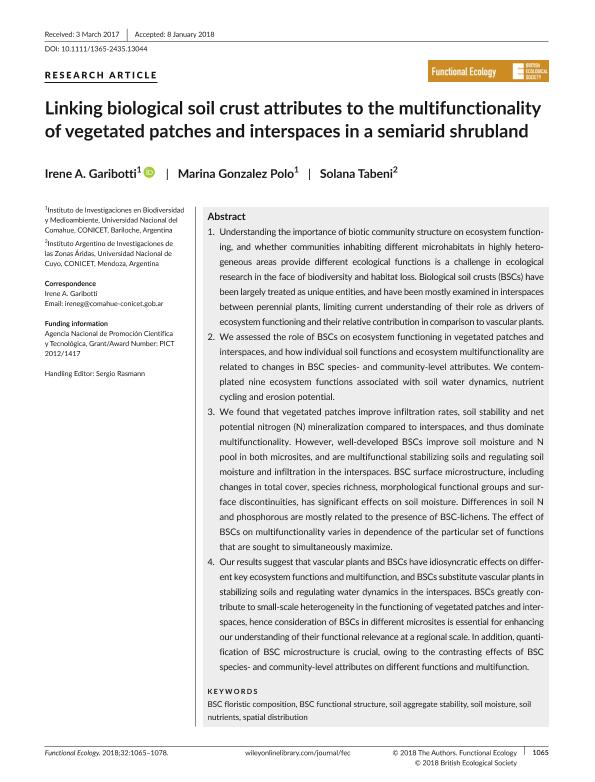Artículo
Linking biological soil crust attributes to the multifunctionality of vegetated patches and interspaces in a semiarid shrubland
Fecha de publicación:
04/2018
Editorial:
Wiley Blackwell Publishing, Inc
Revista:
Functional Ecology
ISSN:
0269-8463
Idioma:
Inglés
Tipo de recurso:
Artículo publicado
Clasificación temática:
Resumen
Understanding the importance of biotic community structure on ecosystem functioning, and whether communities inhabiting different microhabitats in highly heterogeneous areas provide different ecological functions is a challenge in ecological research in the face of biodiversity and habitat loss. Biological soil crusts (BSCs) have been largely treated as unique entities, and have been mostly examined in interspaces between perennial plants, limiting current understanding of their role as drivers of ecosystem functioning and their relative contribution in comparison to vascular plants. We assessed the role of BSCs on ecosystem functioning in vegetated patches and interspaces, and how individual soil functions and ecosystem multifunctionality are related to changes in BSC species- and community-level attributes. We contemplated nine ecosystem functions associated with soil water dynamics, nutrient cycling and erosion potential. We found that vegetated patches improve infiltration rates, soil stability and net potential nitrogen (N) mineralization compared to interspaces, and thus dominate multifunctionality. However, well-developed BSCs improve soil moisture and N pool in both microsites, and are multifunctional stabilizing soils and regulating soil moisture and infiltration in the interspaces. BSC surface microstructure, including changes in total cover, species richness, morphological functional groups and surface discontinuities, has significant effects on soil moisture. Differences in soil N and phosphorous are mostly related to the presence of BSC-lichens. The effect of BSCs on multifunctionality varies in dependence of the particular set of functions that are sought to simultaneously maximize. Our results suggest that vascular plants and BSCs have idiosyncratic effects on different key ecosystem functions and multifunction, and BSCs substitute vascular plants in stabilizing soils and regulating water dynamics in the interspaces. BSCs greatly contribute to small-scale heterogeneity in the functioning of vegetated patches and interspaces, hence consideration of BSCs in different microsites is essential for enhancing our understanding of their functional relevance at a regional scale. In addition, quantification of BSC microstructure is crucial, owing to the contrasting effects of BSC species- and community-level attributes on different functions and multifunction. A plain language summary is available for this article.
Archivos asociados
Licencia
Identificadores
Colecciones
Articulos(IADIZA)
Articulos de INST. ARG DE INVEST. DE LAS ZONAS ARIDAS
Articulos de INST. ARG DE INVEST. DE LAS ZONAS ARIDAS
Articulos(INIBIOMA)
Articulos de INST. DE INVEST.EN BIODIVERSIDAD Y MEDIOAMBIENTE
Articulos de INST. DE INVEST.EN BIODIVERSIDAD Y MEDIOAMBIENTE
Citación
Garibotti, Irene Adriana; Gonzalez Polo, Marina; Tabeni, Maria Solana; Linking biological soil crust attributes to the multifunctionality of vegetated patches and interspaces in a semiarid shrubland; Wiley Blackwell Publishing, Inc; Functional Ecology; 32; 4; 4-2018; 1065-1078
Compartir
Altmétricas




